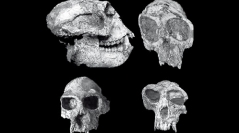

 Geodiversitas
31 (4) - Pages 817-850
Geodiversitas
31 (4) - Pages 817-850The presence of the cercopithecids in the Neogene of Greece is known since the beginning of the 19th century. The excavations of the last 20 years increase their number in Greece. The main taxon of the cercopithecids is Mesopithecus Wagner, 1839 found originally in the middle Turolian (MN 12) locality of Pikermi, near Athens. The Pikermi Mesopithecus sample is rich and belongs to a medium-sized form, M. pentelicus Wagner, 1839. Besides the well-known M. pentelicus, two other species were recognized. The new species M. delsoni Bonis, Bouvrain, Geraads & Koufos, 1990, a large-sized form found in the early Turolian (MN 11) locality Ravin des Zouaves-5 of Axios Valley (Macedonia, Greece) has several differences from the type species. In the middle Turolian (MN 12) localities of Vathylakkos (Axios Valley) and Perivolaki (Thessaly) a large to medium-sized Mesopithecus form with “delsoni” and “pentelicus” characters was found and is referred to as M. delsoni/pentelicus. A small-sized form named M. cf. monspessulanus was recognized by a mandibular fragment in the late Turolian (MN 13) locality Dytiko-2 of Axios Valley and indicates the early appearance of the taxon at the end of Miocene. The rest of the material found in the late Turolian localities of Dytiko has some differences from the typical M. pentelicus. Moreover, Mesopithecus was traced in several late Miocene localities, indicating its wide distribution in Greece. Two other cercopithecids were also found in the Pliocene of Greece. Dolichopithecus ruscinensis Depéret, 1889 was recognized in the locality of Megalon Emvolon and in Ptolemais Basin (Macedonia, Greece); both are dated to late Ruscinian (MN 15). The second Pliocene cercopithecid is Paradolichopithecus arvernensis (Depéret, 1929), found in the locality of Vatera (Lesvos Island) and dated to late Pliocene. The stratigraphic distribution and the palaeoenvironment of these cercopithecids are also discussed.
Mammalia, Primates, Cercopithecidae, Mesopithecus, Dolichopithecus, Paradolichopithecus, Neogene, Greece, systematic, biostratigraphy, palaeoecology